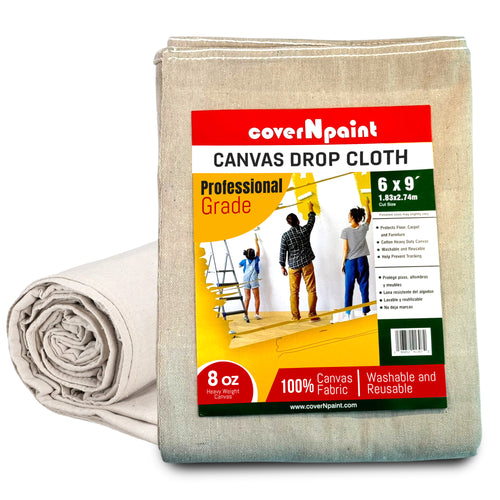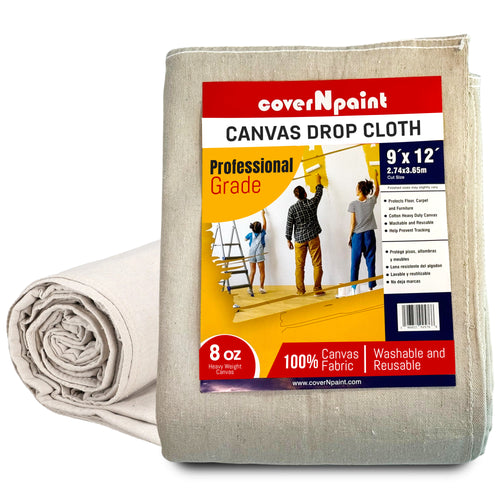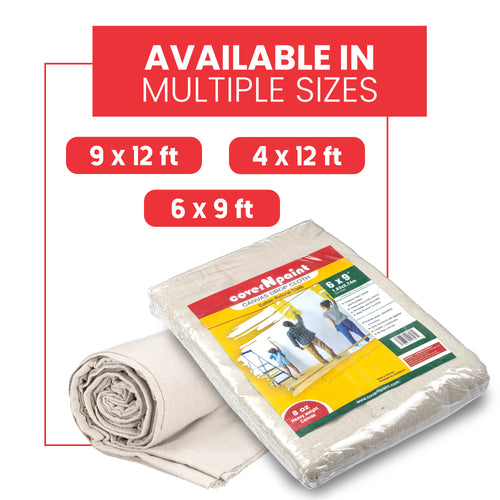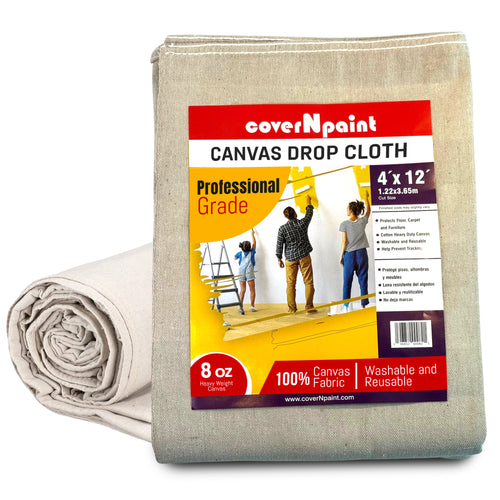When you embark on a painting project, one of the most crucial items you'll need is a painters drop cloth. Whether you’re protecting your floors from spills, shielding your furniture from paint splatters, or creating a safe workspace, a drop cloth plays a vital role. But have you ever wondered what makes a canvas drop cloth effective at doing its job? What’s the science behind its weave, weight, and durability? This blog will explore how these elements come together to make a paint drop cloth the best tool for any painting project.
Understanding the science behind a painters drop cloth can help you choose the right cloth for your needs and maximize its performance. Let’s dive into the key components that make a drop cloth more than just a protective covering.

1. Weave: The Foundation of Protection
The weave of a canvas drop cloth is the first thing that influences its ability to protect your floors and furniture during a painting project. The weave refers to the way the fibers of the cloth are interlaced, determining its strength, durability, and absorption capacity.
Types of Weave Used in Canvas Drop Cloths
There are different types of weaves, but the most common for painters drop cloths are plain weave and twill weave. Here’s how they differ:
-
Plain Weave: The most common weave for drop cloths, where fibers are woven over and under at a 90-degree angle. This results in a durable, balanced fabric that holds up well under pressure. It allows the cloth to be absorbent and stable, offering the perfect surface for paint to land without seeping through.
-
Twill Weave: A slightly more complex weave where threads are woven in a pattern that creates a diagonal line. Twill weaves tend to be stronger and more resistant to wear and tear, making them ideal for larger projects. However, they can be less absorbent than plain weave fabrics.
Why Does Weave Matter?
The tighter the weave, the stronger and more durable the cloth becomes. This is especially important when dealing with paint drips and splatter, as a looser weave would allow paint to seep through to your floors or furniture. A canvas drop cloth with a tight weave provides better protection and absorption.
2. Weight: How Heavier Cloths Provide Better Coverage
The weight of a paint drop cloth significantly impacts its effectiveness in preventing paint spills and splatters. Weight is typically measured in ounces per yard (oz/yd²) and gives you an idea of the fabric’s thickness and density.
What Weight is Ideal for a Painters Drop Cloth?
-
Lightweight (4 oz/yd² to 7 oz/yd²): Ideal for small DIY projects where portability and ease of use are important. These cloths are better suited for light protection tasks like protecting furniture and smaller areas.
-
Medium-weight (8 oz/yd² to 10 oz/yd²): This weight is often used for general painting projects and is the most popular choice for homeowners. It offers a good balance between protection and ease of handling.
-
Heavyweight (12 oz/yd² and above): Heavyweight canvas drop cloths provide the best coverage and absorption. These are ideal for large-scale projects or for use in areas where more substantial protection is needed, like industrial painting or covering expansive floor areas.
Why Does Weight Matter?
The weight of the painters drop cloth contributes to its strength and durability. Heavier fabrics are more resistant to tearing and can withstand more abrasion. They’re also better at absorbing paint, preventing it from soaking through to the surface underneath.
3. Durability: The Key to Long-Lasting Protection
When choosing a canvas drop cloth, durability is one of the most important factors to consider. Durability refers to how well the cloth can handle repeated use, washing, and exposure to harsh conditions like wet paint.
How Is Durability Measured?
Durability is influenced by several factors, including:
-
Thread Count: Higher thread counts generally mean a stronger, more durable cloth. Higher-quality painters drop cloths are woven with thicker threads to ensure they can withstand frequent use.
-
Fabric Composition: Most canvas drop cloths are made from cotton or a cotton-polyester blend. While 100% cotton is breathable and durable, a cotton-polyester blend can add extra strength and resistance to wear.
-
Reinforced Edges: High-quality canvas drop cloths often come with reinforced edges to prevent fraying and ensure the cloth lasts longer. This is particularly useful in high-traffic areas where the cloth is likely to be moved frequently.
Why Does Durability Matter?
A more durable paint drop cloth lasts longer and can be used for multiple projects. It’s an investment that will continue to provide protection for years. Furthermore, a durable canvas drop cloth is less likely to tear during heavy-duty use, ensuring that your floors and furniture stay safe from paint splatters.
4. Why Canvas Is The Ideal Material
When it comes to painters drop cloths, canvas is the undisputed material of choice. Why? Because canvas combines the right balance of strength, absorbency, and flexibility, making it the go-to material for painters.
Benefits of Canvas for Painters Drop Cloths
-
Absorbency: Canvas fibers naturally absorb liquid, which is crucial for soaking up paint and preventing spills from reaching the surface underneath.
-
Breathability: Unlike plastic, canvas allows air to circulate, reducing the chances of mildew or mold growth, especially when used in damp conditions.
-
Sustainability: Canvas is more eco-friendly than plastic drop cloths because it’s reusable and can be washed multiple times, reducing waste.
5. How to Choose the Right Painters Drop Cloth
Now that we’ve explored the science behind the material, it’s important to choose the right canvas drop cloth based on your project’s needs. Here are some tips for selecting the best paint drop cloth:
-
For small rooms: A medium-weight canvas drop cloth (8-10 oz/yd²) is ideal for painting walls and furniture in smaller spaces.
-
For larger projects: Heavy-duty clothes (12 oz/yd² and above) are perfect for protecting large floors and covering significant areas.
-
For long-term use: Choose a high-quality, durable canvas drop cloth that can withstand multiple uses and washes.

A Note For Curious Readers
When considering the best canvas drop cloth for your project, it’s important to choose a supplier that prioritizes quality and durability. Companies like coverNpaint specialize in providing premium canvas drop cloths and tool aprons, designed specifically for professional-grade protection and performance. If you're looking for high-quality, long-lasting products that stand up to the demands of any painting job, it's worth exploring trusted brands that offer reliable materials for your next project.
6. FAQs
1. What’s the Best Material for a Painter's Drop Cloth?
Canvas is the best material for painters drop cloths due to its absorbency, durability, and ability to withstand repeated use.
2. Can I Reuse a Painter's Drop Clothes?
Yes, canvas drop cloths are reusable and can be washed multiple times, making them a more eco-friendly and cost-effective option than plastic.
3. What Size Painters Drop Cloth Do I Need?
It depends on the area you're covering. For floors, a 9x12 ft drop cloth is a common size. For furniture, a 4x12 ft or 6x9 ft cloth may suffice.
4. How Do I Clean Canvas Painters Drop Cloth?
Shake off excess paint and dirt, then machine wash on a gentle cycle with mild detergent. Air dry to preserve the fabric.
5. Are Drop Cloths Waterproof?
No, canvas drop cloths are not waterproof, but they are highly absorbent, which helps in preventing paint from seeping through.












